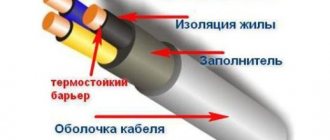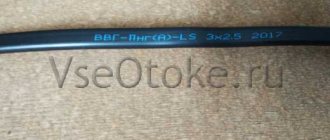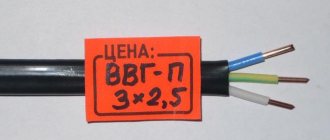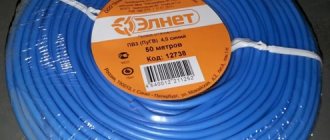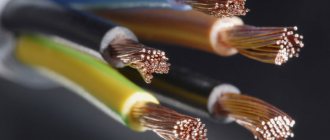How to mark
The most reliable method of marking cable lines is stamping. On the other hand, this method requires the presence of special equipment (a printer), which cannot always be used.
In many ways, the choice of a specific method depends on the material used to make the cable tag. You can also buy markers with already prepared symbols, sold in ribbons. They have cuts that allow you to quickly and accurately remove the desired label and fix it on the wire using an adhesive surface.
The inscriptions are made from waterproof paint or ink. If the electrical circuit is installed in rooms with high humidity levels or is constantly exposed to an aggressive environment, then the marking is applied by milling, punching, burning or stamping on plastic/metal.
For dry rooms with good ventilation or air conditioning, you can get by with marking using standard means - a pencil or felt-tip pen.
SIP cable marking
Self-supporting insulated wire is used in networks of 0.4, 1, 6-35 kW and is used for:
- installation of linear branches;
- construction of highways;
- construction of inputs into residential and administrative buildings.
Types/designation
| SIP-1 | Four-wire cable made of aluminum or aluminum alloy, three cores are covered with light-resistant polyethylene, the fourth without braid with a steel core, plays the role of carrier and neutral |
| SIP-2 | All cores are insulated, including the carrier one |
| SIP-3 | Single-core steel-aluminum cable, sheath made of cross-linked light-stabilized polyethylene |
| SIP-4 | All four cores are insulated with light-stabilized thermoplastic polyethylene, there is no separate load-bearing core |
| SIP-5 | The number of cores is two or more, there is no separate load-bearing core, the rest are covered with a sheath of cross-linked polyethylene |
Brands of aluminum wires
Aluminum wires are marked with the letter A and are manufactured in accordance with GOST 839-80*E. They produce the following brands: APV, APPV, APPR, APR, APRN.
Steel-aluminum wire consists of one steel wire and six aluminum wires. They produce the following brands: AS, ASKS, ASK, ASKP.
AVBbShv acts as an armored aluminum cable laid in the ground.
IMPORTANT! When choosing wires and power cables, important criteria are the material of manufacture and the cross-section of the wires. Calculation data is necessary when determining the wire cross-section, for example, for 6 kW and an operating voltage of 380 V
Aluminum wires can be either without insulation or with enamel insulation (grades: PEEA-155, PEVA, PEEA-130), intended for the manufacture of windings of electrical machines, devices and devices.
Copper wire marking
Types/applications
Flat shape, two or three cores, monolithic core, double insulation
Installed under plaster
Round, three-core, triple insulation, solid core
In screed, in pipes on the surface and underground
Round, five-core, triple insulation, solid core
Round, three and five cores, double insulation, composite core
When installing drywall due to its flexibility
The absence of the letter A in the marking means that the wire is made of copper (VVG).
Twisted pair cable marking – TP, UTP, FFTP. Today there are seven categories of twisted pair cables in use, the difference being the cable bandwidth. Their designation is cat. 1, cat. 2, cat. 3, cat. 4, cat. 5e, cat. 6, cat. 6a, cat. 7, cat. 7a.
Bare copper wire grade M is structured from one or more wires twisted together. The main purpose is the transmission of electricity through airways, in atmospheric conditions of types II and III. The designation M itself indicates the material from which the wire is made.
Types/labels
| Copper plated steel conductor | CCS |
| Copper plated with aluminum core | CCA |
Network Cable Types
| Types of Ethernet Cables | Network cable markings |
| Unprotected shielded twisted pair | U/STP |
| Protected twisted pair | UTP or FFTP |
| Coaxial | DOCSIS |
| Fiber Optic | Loose Tube |
Rubber cable marking
Wires and cables are marked with letters, 3 of which indicate the core insulation material.
Designations
| R | Rubber |
| HP | Non-flammable rubber |
| PRS | Flexible wire, with twisted copper cores, rubber insulation, in a rubber sheath |
| GK | Heating cable designation |
Marking of control cables
Types/labels
| With a cross-section of cores 1; 1.5; 2.5; 4 mm2 | KVVG |
| There are 4, 5, 7, 10, 12, 14, 19, 27, 37 cores in the bundle | KVVGE |
| KVVGng | |
| KVVGng-LS | |
| KVBBbShv | |
| AKVVG, AKVVGE, AKVVGng, AKVVGng-LS, AKVBbShv – with aluminum conductors | |
| PKLS | Intercontinental submarine cable lines |
A container is used for the safety and delivery of cables.
What GOST and PUE say about color marking
The main document that you should rely on when producing or purchasing cables is GOST 31947-2012. Before its appearance, there was no uniformity and order in the field of color designation of electrical wiring.
Until now, in old houses you can find wires in the same sheath, the color of which cannot determine what is connected - “phase”, “zero” or “ground”.
Now it has become much easier to identify veins. Even without using a tester, you can determine which contact a particular core should be connected to - by the color of the polymer insulation
The above-mentioned GOST document states that the insulation of cable products should differ in color. A certain shade should cover the wire with a continuous layer - from beginning to end. It is impossible for one wire at the beginning of the bay to be blue and the end to be white; Intermittent painting is also prohibited.
The only vein that can have a two-color shell is the “ground”. Officially, it is assigned the green/yellow combination; these two shades cannot be used separately
The regulatory documents also contain recommendations for the use of various circuits for 3-core, 4-core and 5-core cables.
For example, when producing 3-core cables, the following combinations are welcome:
- brown – blue – green/yellow;
- brown – gray – black.
If the cable consists of 4 cores, then two standard color options are also recommended:
- brown – gray – black – green/yellow;
- brown – gray – black – blue.
The diagrams for a 5-core wire look like this:
- brown – gray – black – green/yellow – blue;
- brown – gray – 2 black – blue.
The blue color indicates the “zero” core.
It is not recommended to use only two colors - red and white.
There are special requirements for the distribution of colors of the grounding conductor: on any randomly selected piece of wire 1.5 cm long, one color must cover 30-70% of the insulation, the second color must cover the remaining area
The color must be applied firmly and be clearly visible.
If you turn to the second important document for electricians - the PUE, then in clause 1.1.29 and clause 1.1.30 you can also find information about the color of the phase-neutral-ground wires. More precisely, the data is not listed there, but there is a reference to GOST R 50462-92, which has long been replaced by a more recent edition of GOST R 50462-2009, which is still in force today.
The material corresponds to the information set out in GOST 31947, but there are some clarifications. For example, wires that perform a dual function should be painted in a special way: if the zero worker is combined with the zero protective wire, then it is painted blue along its entire length and has green-yellow stripes along the edges.
Schematic representation of the color marking of conductors. Along with the color designation, the cores also have a letter: zero - N, protective - PE, combined zero + protective - PEN
Thus, all colors, with the exception of blue (cyan) and green/yellow, can be used to color the insulation of the phase conductor. This group includes white and red colors, which for some reason are not recommended for use by the 2012 edition of GOST.
An example of a three-core cable manufactured in accordance with GOST standards: green/yellow conductor is intended for grounding, blue – neutral, brown – phase
In Appendix A to GOST R 50462 there is a table in which you can find the letter designations of all colors. For example, the phase conductor of a 1-phase circuit (L) is painted brown, the color code is BN. Letter codes are used for black and white copies of diagrams that do not use different colors.
Designation of special cable characteristics
Helps to understand the special performance characteristics of the cable. Let's consider them according to GOST:
- “A” means that the cable is paved;
- “B” has armor tapes;
- “G” is a flexible wire without protection;
- “K” is armored with round wire;
- “T” is made for use on pipe bases;
- “O” received additional protection in the form of braiding.
Let us note the designation frls, since although it is added at the end, it provides information about combustion resistance, which is important for fire safety. It is divided into two abbreviations
FR indicates the level of fire resistance, and LS indicates the small amount of smoke produced when ignited.
Now you know how to correctly decipher cables or wires and can understand their markings. This will help in various situations related to laying electricity to buildings or creating wiring inside them using your own efforts.
Designation of cable products:
Cables and wires are divided according to the following criteria:
- by product type:
- installation wire ( Pu
); - installation cable ( Ku
);
- for installation and operating conditions that do not require increased flexibility ( no designation
); - requiring increased flexibility ( G
),
- polyvinyl chloride plastic compounds, including low fire hazard and heat-resistant ( B
); - polymer compositions that do not contain halogens ( P
).
- flame retardant when installed alone ( no designation
); - flame retardant when laid in groups, with reduced smoke and gas emissions - ng(A, B, C, D)-LS
- flame retardant when laid in groups, with reduced smoke and gas emissions, with low toxicity of combustion products - ng(A, B, C, D)-LSLTx
; - non-flammable when laid in groups and non-emitting corrosive gaseous products during combustion and smoldering - ng(A, B, C, D)-HF
; - do not propagate fire when laid in groups and do not emit corrosive gaseous products during combustion and smoldering, with low toxicity of combustion products - ng(A, B, C, D)-HFLTx
.
Rules and standards for marking wiring in electrical panels
The colors for marking the wiring were chosen for a reason. All the variety of colors comes down to one standard - standard rules. They are prescribed in the rules for technical operation of consumer electrical installations (PTEEP). It states that the conductors of electrical wires must be designated by color or letters and numbers, and the cabinet itself also requires designations. You can find out what types of wire color markings exist in our article.
The PUE states that:
- The electrical panel must have a name. This name is indicated on the body. In the electrical panel of the apartment it does not need to be marked with inscriptions. But for a private house, when the shield is placed on a pole, this is necessary.
- When installing it, you must leave a sheet inside the panel where all consumers (sockets and lamps) are indicated in table form.
- Also, inside there should be an assembly diagram for the input panel. This rule applies only to the device that was purchased assembled.
Note: if an electrician assembles a panel or cabinet, then you should definitely take the assembly diagram from him.
According to the same rules and PUE:
- Chapter 2.3. PUE clause 2.3.23. “Each cable line must have its own number or name...”.
- PTE EP clause 2.4.2 “Openly laid cables, as well as all cable couplings must be provided with tags.”
- There is marking on the circuit breakers or on the information board of the installation indicating the wiring group. Also, according to the rules, the serial number and name of the room or the purpose of the group (for example, a kitchen or an air conditioner) must be indicated.
- In the event that there is no space for recording on a modular device, marking with the purpose of this installation is made in the table and passport, which each cabinet must have.
According to GOST, wires are designated:
- In accordance with GOST 23594–79 (marking), the wire or cable is marked with tags or PVC tapes. PVC and heat-shrinkable tubes can serve as tags.
- The inscriptions on the label are written in a legible font and must be clearly visible. The length of the tag itself should not be less than 25 mm.
- According to the standards, markings can be applied to a wire or cable (to its insulation). Only on condition that such an inscription will be clearly visible.
We have figured out the basic rules for applying identification marks. Now let's look at how you can mark wires during installation.
Selection of conductor cross-section
The cross-section of electrical communication lines used should not be less than the value that ensures the maximum current density for the given installation conditions. On average, based on long-term operation, this value is 1 - 3 amperes per square millimeter. The real current is found by dividing the consumer's voltage by the total resistance of parallel-connected loads. If the line is small, then the voltage at the consumer can be taken equal to the source emf. You can also select the cross section based on the available current using the table.
HOW TO UNDERSTAND THE MARKING OF WIRES
Wire marking
There are a large number of different brands of wire - PVA 2x0.75; PUGV 1x2.5; ShVVP 2x0.5; APPV 2x2.5; PUGVV 2x1.5, etc., but what do these letters and numbers mean in their markings?
In the wire marking, after the letter designation, the number of current-carrying cores and their cross-sectional area are written in numbers, i.e. the inscription 3x1.5 means that the wire contains three cores with a cross-sectional area of one and a half millimeters each.
The following classification is adopted for wire marking:
- “A” – aluminum. Indicates that the material of the conductive wires is aluminum; if the letter A is absent, then the wire is based on copper conductors;
- “P” means “wire”;
- “PP” – “flat wire”;
- “G” – flexible conductors. (for example, PRGI).
After the letter “P” there is a letter that characterizes the insulation material:
In addition, the insulation is often protected by various shells:
- “B” – the wire has an additional sheath of PVC plastic;
- “N” – non-flammable shell;
- “L” is a braid made of cotton yarn coated with varnish. The letter L is placed in last place in the designation of the wire brand;
- “TO” – braid impregnated with an anti-rot compound, for installation in steel pipes (for example, PRTO).
Wires for overhead power lines are deciphered as follows:
- SIP is a self-supporting insulated wire. Insulation made of light-stabilized cross-linked polyethylene;
- SIP-1 – with uninsulated neutral;
- SIP-2 – with insulated neutral;
- SIP-4 – with insulated conductors of equal cross-section;
- A – bare wire twisted from aluminum wires;
- AC is a bare wire consisting of a steel core and aluminum wires.
Wires for electrical installations of the PV brand have digital indices 1; 2; 3 and 4. These numbers indicate the degree of flexibility of the wires. The higher the value, the more flexible the wire.
Let's look at all of the above using an example: PVS wire 2x0.75
- This cable has 2 copper cores, 0.75 sq. mm. each;
- P – wire;
- B – vinyl shell made of polyvinyl chloride (PVC) plastic;
- C – connecting.
Cable marking Cable marking is done in the same way:
For VVG cable:
- A – current-carrying conductor – aluminum. If the letter A is missing, then the conductor is made of copper;
- B – vinyl. Shell made of polyvinyl chloride (PVC) plastic;
- B – vinyl. Insulation made of polyvinyl chloride (PVC) plastic;
- G – flexible or unarmored.
Depending on the group of use, the following designations are found in cable markings:
VVG-P:
“P” – layered, insulated cores are laid parallel in one plane.
VVGz:
“z” – with filling, filling made of rubber mixture.
VVGng:
“ng” - non-flammable, PVC plastic compound of reduced flammability.
VVGng -LS:
- “LS” – “low tuxedo” (low smoke emission), PVC of reduced fire hazard.
- “FR” - from the English fire resistant, which means “fire resistant”
AVBbShv:
- B – armor made of steel tapes;
- Ш - protective hose made of PVC plastic;
- c – vinyl. Insulation made of polyvinyl chloride (PVC) plastic.
ASB2lG, ASKl, TsSB:
- C – lead sheath;
- 2l – two lavsan ribbons;
- G – naked. Protective cover made of two galvanized steel strips;
- K – protective cover made of round galvanized steel wires;
- C – paper insulation impregnated with a non-drip compound.
AKVVGE:
- K – control;
- E – common screen made of aluminum foil over twisted cores;
APvBbShp:
- “P” – insulation made of silanol cross-linked polyethylene;
- “p” – outer shell made of polyethylene.
APvPu2g:
- “u” – reinforced polyethylene shell;
- “2g” – “double sealing”, cross-linked polyethylene insulation with aluminum tape over a sealed screen.
KG:
ASRG, AVRG, VRG:
APsVG, APVGi, etc.:
VVGng(ozh):
“(ozh)” – single-core. If there is no “ozh” in the brand, this means, by default, that the design is stranded (mp) or multi-core (mn).
Let's look at all of the above using an example: cable VVGng (ozh) -0.66 kV 3x1.5
- This cable has 3 copper cores, 1.5 sq. mm. each;
- B – vinyl shell made of polyvinyl chloride (PVC) plastic;
- B – vinyl insulation made of polyvinyl chloride (PVC) plastic;
- (ng) – non-flammable material.
- 0.66 kV – voltage. For this cable it is 660 V. In general, cables are low voltage (0.38 -1 kV), medium (6-35 kV) and high voltage (110-500 kV).
- (ozh) – execution – single-core.
Common labeling mistakes
Let's list three main mistakes:
- The most common one is caused by novice electricians or experienced specialists due to inattention. In the process of screwing the wire to the shield and terminals, the craftsmen simply forget to put a heat-shrinkable tube with markings (tube) on the wires. Because of this, you have to unscrew the attached wiring and put the products on again.
- Often craftsmen confuse the PEN conductor with a grounding cable. The fact is that both elements have identical color markings, so you need to inspect them more carefully.
- If the panel is located outside the site, then it is necessary to conclude an agreement with the electrical energy supplier. You must have on hand technical documentation with a diagram and confirmation of compliance with the requirements of the PUE, PTEEP and other regulatory acts. Otherwise, you may face claims from Rostekhnadzor.
Qualified specialists will agree to carry out repair work and engage in maintenance of emergency areas only if sufficient information about the parameters of the line is provided. This is exactly what is contained on the cable tags.
Requirements for inscriptions on tags
Tags on the cable, secured with clamps or threaded through the wire, must be signed in a certain way; this rule is regulated by the rules of the PUE. In accordance with this document, the following data is applied to the label:
- Cable or line number. This is information that contains data about the direction of the highway, what it feeds, and what level of protection is required. During the wiring installation process, an object passport is drawn up, which indicates the buildings or premises powered by this line. They are assigned numbers, which will subsequently be written on the tag itself; during the service process, the technician will be able to look at the markings of the cables and, by comparing them with the object’s passport, understand where this or that line leads;
- Brand and cross-section of wire. Since space on the tag is limited, the designation is written abbreviated, with a minimum number of characters. For example, a vinyl-coated cable with a cross-section of 3*2.5 is briefly designated VVG-3/2.5;
- Line voltage. This is a mandatory parameter, since it is not clear from the outer sheath of the cables what voltage the current flows through it, respectively, and what level of protection is required during repair work;
- The beginning and end of cable lines. For more accurate information about possible losses on the main line after its installation, a designation of the total length is applied. After reading the data, the technician servicing the wire line will be able to accurately calculate the resistance and level of voltage loss in the network.
Labels on tags
All of the information listed is basic and mandatory. It is not prohibited to place additional information on the tag that characterizes the electrical main, for example, the date of laying. In addition, when placing a tag on the coupling, it is necessary to place the date of installation of the wire, since the coupling has its own resource, which will be calculated based on this indicator.
Inscriptions on metal tags are most often made by engraving with a special pencil or indelible paint. Plastic products are signed with a permanent marker or indelible paint. Also, when placing a tag using wire on a highway, it is necessary to additionally protect metal objects with bituminous composition or any other paint, otherwise the wire will rust and collapse, and the tag will be lost. Nylon thread is best suited for fastening; it is not afraid of temperature changes and high humidity.
Tag for threading onto wire
Recently, to indicate the cable on the line, many electricians began to use stickers that already have inscriptions informing about the voltage, as well as empty spaces in which additional data is written. Such stickers are very convenient, since the master does not waste time making markings, but simply glues the element onto the finished tag and continues installation.
Types of cable products
You need to clearly understand the differences between a wire and a cord and a cord and a cable. Marking of wires and cables is carried out according to one GOST.
A wire is a product made from one or more cores twisted together. Products are produced with or without applied insulation.
Insulated cable
Widely used in the production of electric motors, generators and other types of industrial products.
The main area of application of a flexible cord is connecting various electrical appliances for household and industrial purposes to the network.
Decoding the marking allows you to accurately determine the scope of application of the product. The range of manufactured cables is divided into the following groups:
- power;
- control;
- radio frequency;
- management;
- communications.
For each type of product, GOST has been developed, which regulates the technical characteristics and operating conditions of each product.
Cable type VVG is not used in communication networks. In the same way, the use of the coaxial standard in power supply systems is prohibited.
According to building codes and regulations, each wire laid in a tray must have tags that are located every 50 meters.
Power
This type of product includes VVG and SIP wires. They are used in power, lighting and household circuits.
Types of power cables
GOST prescribes that wiring in domestic premises should be carried out with a cable made of copper conductors.
For special conditions, armored products are installed in mines and underground galleries.
Tests
These products are used in remote control systems to power electrical devices.
The number of conductors, according to GOST, varies from 4 to 37.
Control cable example
Labels with the prescribed information are attached to both ends of the cable.
Radio frequency
Cables are produced to transmit high-frequency signals from one electronic device to another.
Coaxial type product.
RF cable device
Copper inner wire.
On top of the insulation, a second conductor and a plastic protective sheath are applied.
Management
The products are used in remote control structures for various mechanisms.
Control cable example
Unlike the coaxial type, they have a number of current-carrying cores from 3 to 108.
Connections
A special type of cable is used to transmit information and communication signals between subscribers.
The number of copper cores is determined by the purpose of the cable.
High frequency communication cable
The product is divided into two types - low-frequency and high-frequency.




